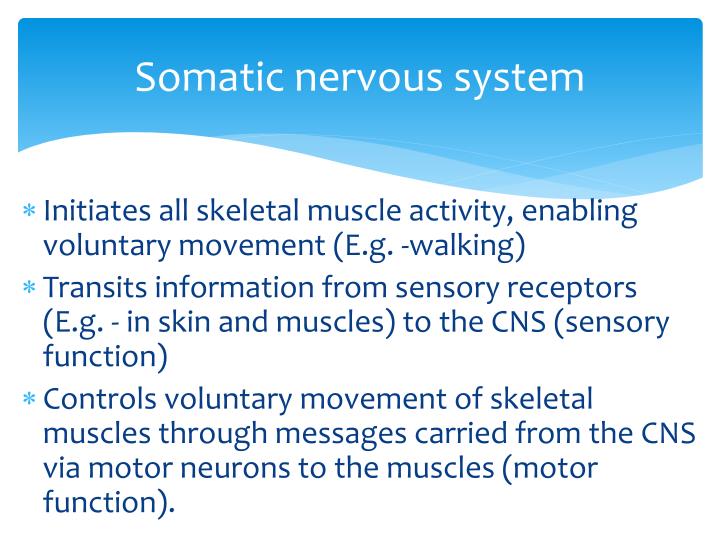

The somatic nervous system (SNS) is the division of the PNS that controls the external aspects of the body, including the skeletal muscles, skin, and sense organs. Many of the actions of the ANS, such as heart rate and digestion, are automatic and out of our conscious control, but others, such as breathing and sexual activity, can be controlled and influenced by conscious processes. The autonomic nervous system (ANS) is the division of the PNS that governs the internal activities of the human body, including heart rate, breathing, digestion, salivation, perspiration, urination, and sexual arousal. As you can see in Figure 4.18, “The Autonomic Nervous System,” the peripheral nervous system is itself divided into two subsystems, one controlling internal responses and one controlling external responses. The PNS links the CNS to the body’s sense receptors, muscles, and glands. If the central nervous system is the command centre of the body, the peripheral nervous system (PNS) represents the front line. These quick responses, known as reflexes, can reduce the damage that we might experience as a result of, for instance, touching a hot stove.

The central nervous system can interpret signals from sensory neurons and respond to them extremely quickly via the motor neurons without any need for the brain to be involved. When you touch a hot stove and immediately pull your hand back, or when you fumble your cell phone and instinctively reach to catch it before it falls, reflexes in your spinal cord order the appropriate responses before your brain even knows what is happening. Reflexes are triggered when sensory information is powerful enough to reach a given threshold and the interneurons in the spinal cord act to send a message back through the motor neurons without relaying the information to the brain (see Figure 4.17, “The Reflex”). A reflex is an involuntary and nearly instantaneous movement in response to a stimulus. When a quicker-than-usual response is required, the spinal cord can do its own processing, bypassing the brain altogether. Within the spinal cord, ascending tracts of sensory neurons relay sensory information from the sense organs to the brain while descending tracts of motor neurons relay motor commands back to the body. It is the central throughway of information for the body. The spinal cord is the long, thin, tubular bundle of nerves and supporting cells that extends down from the brain. Interneurons allow the brain to combine the multiple sources of available information to create a coherent picture of the sensory information being conveyed. An interneuron, which is by far the most common type of neuron, is located primarily within the CNS and is responsible for communicating among the neurons. A sensory (or afferent) neuron carries information from the sensory receptors, whereas a motor (or efferent) neuron transmits information to the muscles and glands. Nerves are differentiated according to their function. Figure 4.16 The Functional Divisions of the Nervous System. Everything that we see, hear, smell, touch, and taste is conveyed to us from our sensory organs as neural impulses, and each of the commands that the brain sends to the body, both consciously and unconsciously, travels through this system as well. The CNS interprets information coming in from the senses, formulates an appropriate reaction, and sends responses to the appropriate system to respond accordingly. The central nervous system (CNS), made up of the brain and spinal cord, is the major controller of the body’s functions, charged with interpreting sensory information and responding to it with its own directives. The nervous system (see Figure 4.16, “The Functional Divisions of the Nervous System”), the electrical information highway of the body, is made up of nerves - bundles of interconnected neurons that fire in synchrony to carry messages. Electrical Control of Behaviour: The Nervous System How do the complex activities in the various parts of the brain, the simple all-or-nothing firings of billions of interconnected neurons, and the various chemical systems within the body work together to allow the body to respond to the social environment and engage in everyday behaviours? In this section we will see that the complexities of human behaviour are accomplished through the joint actions of electrical and chemical processes in the nervous system and the endocrine system. Now that we have considered how individual neurons operate and the roles of the different brain areas, it is time to ask how the body manages to put it all together.



 0 kommentar(er)
0 kommentar(er)
